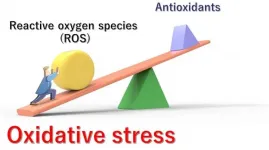(Press-News.org) Oxygen is essential for human life, but within the body, certain biological environmental conditions can transform oxygen into aggressively reactive molecules called reactive oxygen species (ROS), which can damage DNA, RNA, and proteins. Normally, the body relies on molecules called antioxidants to convert ROS into less dangerous chemical species through a process called reduction. But unhealthy lifestyles, various diseases, stress, and aging can all contribute to an imbalance between the production of ROS and the body's ability to reduce and eliminate them. The resulting excessive levels of ROS cause "oxidative stress," which can disrupt normal cellular functions and increase the risk of diseases like cancer, neurodegeneration, kidney dysfunction, and others, which are all accompanied by severe inflammation.
Since oxidative stress is associated with various serious diseases, its detection within living organs offers a route to early diagnosis and preventive treatment, and is, thus, a matter of considerable interest to scientists working in the field of biomedicine. Recent international collaboration between the Japanese National Institutes for Quantum and Radiological Science and Technology (QST), Bulgarian Academy of Sciences, and Sofia University St. Kliment Ohridski in Bulgaria led to a promising technology for this purpose: a novel quantum sensor. Their work is published in the scientific journal Analytical Chemistry, 2021.
According to lead scientist Dr. Rumiana Bakalova and her colleague Dr. Ichio Aoki of QST, "the new sensor is appropriate for the early diagnosis of pathologies accompanied by inflammation, such as infectious diseases, cancer, neurodegeneration, atherosclerosis, diabetes, and kidney dysfunction."
The sensor comprises a quantum dot--semiconductor--core coated with a ring-shaped sugar-like compound called α-cyclodextrin, which in turn is bonded to six redox-sensitive chemical groups called nitroxide derivatives. These components have the advantage of favorable safety profiles, with cyclodextrins being approved for use in food and nitroxide derivatives being considered generally harmless for living beings due to their antioxidant properties.
The nitroxide derivatives cause the sensor to give ON fluorescence signals when in a reduced state and give ON magnetic signals when in an oxidized state. This allows for the detection of oxidative stress, or a reduced cell/tissue capacity, using methods such as magnetic resonance imaging (MRI) and electron paramagnetic imaging (EPR), which can detect magnetic signals. The chemical sensor is also bonded to a compound called triphenylphosphonium, which helps the sensor enter living cells and proceed to the mitochondria, which are the cellular components most often responsible for generating ROS, particularly under pathologic conditions.
To test their novel chemical sensor, the scientists first performed experiments with cultures of normal (healthy) and cancerous colon cells in the lab. For this they used their sensor in the oxidized form. In healthy cells, EPR signals were quenched; but in cancer cells, they stayed strong. This indicates that the sensors were reduced in healthy cells by antioxidants but remained in their oxidized state in the cancer cells, which in turn suggests that the cancerous cells had a higher oxidative capacity.
To further test the sensor, the researchers conducted experiments with both healthy mice and those that had been raised on a high-cholesterol diet for 2 months, which caused them to develop early-stage kidney dysfunction due to persistent inflammation. Compared with the healthy mice, the mice with kidney dysfunction exhibited stronger MRI signals in their kidneys, suggesting that their kidneys were under greater oxidative stress.
This work is in its initial stages and much research is required before these sensors can be ready for medical use. But these findings reveal the potential of such technology. Dr. Bakalova notes: "Our sensor is suitable for analyzing even small redox imbalances associated with the overproduction of ROS, via MRI. And while MRI and CT by themselves have been able to diagnose advanced stage kidney damage, they have not yet been able to visualize early stages of dysfunction. The use of our probe could help clinicians identify patients in the early stage of renal damage before they need hemodialysis or kidney transplantation. With further research, our sensor could be the next generation of redox-sensitive contrast probes for early diagnosis of kidney dysfunction, and perhaps, a number of other diseases that are accompanied by inflammation."
INFORMATION:
Research Article:
Quantum Sensors To Track Total Redox-Status and Oxidative Stress in Cells and Tissues Using Electron-Paramagnetic Resonance, Magnetic Resonance Imaging, and Optical Imaging
Dessislava Lazarova, Severina Semkova, Genoveva Zlateva, Higashi Tatsuya, Ichio Aoki, and Rumiana Bakalova
Analytical Chemistry. DOI: https://doi.org/10.1021/acs.analchem.0c04116
About Dr. Rumiana Bakalova (Chief researcher, QST):
Rumiana Bakalova graduated from the Sofia University "St. Kliment Ohridski" Faculty of Biology with a specialization in biochemistry. She received her Ph.D. degree in 1990 at the Bulgarian Academy of Sciences and a D.Sc. degree in 2011 at the Sofia University "St. Kliment Ohridski". She is currently associated with the National Institutes of Quantum and Radiological Science and Technology, Japan. She is an avid researcher of redox-related molecular mechanisms underlying cancer and their potential as therapeutic targets. To date, she has over 200 publications in prestigious journals, such as Nature Biotechnology, Nature Photonics, The Lancet, Nano Letters, Clinical Cancer Research and others, to her name, as well as 11 patents.
About National Institutes for Quantum and Radiological Science and Technology, Japan:
The National Institutes for Quantum and Radiological Science and Technology (QST) was established in April 2016 to promote quantum science and technology in a comprehensive and integrated manner. QST's mission is to raise the level of quantum and radiological sciences and technologies through its commitment to research and development into quantum science and technology, the effect of radiation on humans, radiation emergency medicine, and the medical use of radiation. To ensure that research and development delivers significant academic, social and economic impacts, and to maximize benefits from global innovation, QST is striving to establish world-leading research and development platforms and explore new fields.
Website: https://www.qst.go.jp/site/qst-english/
Funding information:
This study was funded by the Japanese Society for the Promotion of Science (Grant-in-Aid-C), the Japanese Agency for Medical Research and Development (Next-generation Cancer therapy [P-CREATE]), and the Japanese Science and Technology Agency (Center of Innovation Program).
Media contact:
Public Relations Section
Department of Management and Planning, QST
Tel: +81-43-206-3026 Email: info@qst.go.jp
ATLANTA - FEBRUARY 3, 2021 - New study finds more than half (56.4%) of cancer survivors in the United States reported having additional underlying medical conditions associated with severe COVID-19 illness. The report appearing in JNCI: The Journal of the National Cancer Institute, suggests that prevalence of these conditions among cancer survivors is nearly 40% higher than that in the general population.
Cancer, and other underlying medical conditions, including chronic obstructive pulmonary disease, heart diseases, diabetes, chronic kidney disease, and obesity, are associated with increased risk of severe COVID-19 illness. For this study, investigators Changchuan (Charles) ...
A can of Red Bull next to the computer mouse, a bag of potato chips next to the keyboard - that's how many people imagine nutrition in eSports. "The energy drink is indeed part of the diet for many," says Professor Ingo Froböse, head of the Institute of Movement Therapy and movement-oriented Prevention and Rehabilitation at the German Sport University Cologne, "but overall, eSports players actually eat better than the general population."
This is the result of the third eSport study by the German Sport University Cologne, which was presented in Cologne on February 3, 2021. The two previous eSport studies focused on training ...
As the sea ice shrinks in the Arctic, the plankton community that produces food for the entire marine food chain is changing. New research shows that a potentially toxic species of plankton algae that lives both by doing photosynthesis and absorbing food may become an important player in the Arctic Ocean as the future sea ice becomes thinner and thinner.
Microscopic plankton algae, invisible to the naked eye, are the foundation of the marine food web, feeding all the ocean´s living creatures from small crustaceans to large whales. Plankton ...
A study of factors associated with Post-Traumatic Stress Disorder (PTSD) has led to a number of novel findings linking nutrition to experiences of PTSD. Notable among them is the discovery that Canadians, between the ages of 45 and 85, were less likely to exhibit PTSD if they consumed an average of two to three fiber sources daily.
"It is possible that optimal levels of dietary fiber have some type of mental health-related protective effect," says Karen Davison, Director of the Nutrition Informatics Research Group and Health Science Program Faculty Member at Kwantlen Polytechnic University. "This may be due to the communication network that connects the gut and brain via short chain fatty acids (SCFAs), which are metabolic byproducts of bacterial ...
Eating too much fat and sugar as a child can alter your microbiome for life, even if you later learn to eat healthier, a new study in mice suggests.
The study by UC Riverside researchers is one of the first to show a significant decrease in the total number and diversity of gut bacteria in mature mice fed an unhealthy diet as juveniles.
"We studied mice, but the effect we observed is equivalent to kids having a Western diet, high in fat and sugar and their gut microbiome still being affected up to six years after puberty," explained UCR evolutionary physiologist Theodore Garland.
A paper describing the study has recently been published in the END ...
A brain-related visual impairment, which until recently was thought to be rare, may affect one in every 30 children according to new research investigating the prevalence of Cerebral Visual Impairment [CVI]. The University of Bristol-led findings published today [3 February] in Developmental Medicine and Child Neurology, aim to raise awareness of CVI among parents and teachers to help them identify signs of the condition earlier.
The brain is just as important as the eyes when it comes to seeing, and many vision problems are caused by areas of the brain that are needed for sight not working properly and cannot be resolved by wearing glasses. Brain-related vision ...
During the summer of 2019, a global team of experts put their heads together to define the key questions facing the UK government when it comes to biological security.
Facilitated by the Centre for Existential Risk (CSER) at the University of Cambridge and the BioRISC project at St Catharine's College, the group of 41 academics and figures from industry and government submitted 450 questions which were then debated, voted on and ranked to define the 80 most urgent.
The final line-up includes major questions on future disease threats, including what role shifts in climate and land use might play, and whether data from social media platforms should be used to help detect the earliest signs of emerging pathogens.
Other ...
Environmental pressures may have led humans to become more tolerant and friendly towards each other as the need to share food and raw materials became mutually beneficial, a new study suggests.
This behaviour was not an inevitable natural progression, but subject to ecological pressures, the University of York study concludes.
Humans have a remarkable capacity to care about people well outside their own kin or local group. Whilst most other animals tend to be defensive towards those in other groups our natural tolerance allows us to collaborate today on a global scale, as seen with trade or international relief efforts to provide aid for natural disasters.
Using ...
Mandatory calorie labelling of alcoholic drinks could possibly address both alcohol consumption and obesity. An analysis published in Obesity Reviews summaries the results of studies that have examined consumer knowledge of the calorie content of alcoholic drinks, public support for labelling of calorie content on such drinks, and the effect of labelling on consumption.
In the analysis of 18 relevant studies, there was moderate evidence that people were unaware of the calorie content of alcoholic drinks and that they supported labelling. Studies found no evidence that labelling affected consumption levels, but most studies were of low quality and were not conducted in real-world settings.
"The ...
A recent analysis of published studies estimates that one-quarter of adults with breast cancer have cognitive impairment before starting therapy. The analysis, which is published in Psycho-Oncology, also found that many patients' cognitive function declines after receiving chemotherapy, endocrine therapy, and/or hormone therapy for breast cancer.
"Our results suggest that cancer-related and personal factors may make a significant contribution to cognitive functioning," said lead author Aicha Dijkshoorn, of the University Medical Center Utrecht, in the Netherlands.
The ...



